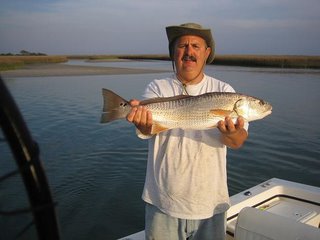Atlantic Bonito
Usually one of the first migratory species to visit us in spring is the Atlantic Bonito (Sarda Sarda). The bonito is related to both the tuna and mackerel families and shouldn't be confused with a similiar fish, the False Albacore, that also visits our coast in the spring. To further confuse the two fish, in Florida they commonly call the False Albie a Bonita (notice the A instead of the O).
It is one of my favorite fish and really gets my fishing blood warmed up in the spring. The bonito arrive on our coast around the first to middle part of April and usually stay until about the middle of May. Once the water gets above 62 degrees you can start looking for them. When they first appear they usually are in schools by themselves but toward the end of their stay they sometimes will be mixed in with schools of Spanish mackerel.
They visit most of the NC coast but seem to congregate mainly in Onlsow Bay and off the Brunswick County beaches. They will come very close to the coastline and seem to prefer underwater structure that breaks up the currents. The near shore artificial reefs are a great place to hunt for them as well as some of the natural reefs and ledges in 40 - 50 feet of water.
The best time to target them is early in the morning around first dawn but you can find them at other times too. They usually travel in large schools and often can be seen busting on balls of baitfish at the surface. Often you can find them by looking for large flocks of birds that will be swarming and diving on the bait. Quite a sight to behold for a set of winter-fatigued eyes!
They spook fairly easy so you should approach them from up current and then drift toward them. Never run into the middle of the school or the busting birds, they will scatter and go deep if you do.
If they aren't on the surface, use your fishfinder in combination with a vertical jigging rig to find them in the water column. Once you have located them and get close enough, they are fairly easy to target. They are a bit leader shy so I use a fluorocarbon leader, never metal or heavy monofilament.
You can fish for them much like you would for Spanish mackerel. I like to use a fast action, light duty rod and reel, much like a flounder or sea trout combo with 10 or 12 pound test line. Many fishermen like to use a light metal jig like a Maria lure or a Lurh Jensen crippled herring to target them on the surface. Anywhere from ½ to 1 ½ ounces usually works well depending on the water conditions. If they are deeper in the water column try using a diving type lure such as the Yo-Zuri Crystal Minnow Deep Diver or pull a Clark spoon on a trolling weight.
The bonito will at first bite seem almost an easy pull, but when the fish realizes it is being pulled away from the school, it will make a FAST run trying to catch up. Then they will begrudge you every inch of line as you reel them in. Once they see the boat it starts all over again, only this time the run isn’t quite as far.
The bonito is a great tasting fish especially if treated properly on the boat. Much like a tuna, they are warm-blooded. Bleed them while they are still alive and then ice them down right away. I like to use a slush made from two parts ice to one part sea water. It will cool them down faster than ice alone.
You can catch a bunch of fish in hurry when the bite is on. While they are a tasty fish, they spoil within several days of being caught. They do not freeze well even in a vaccum pack. The flesh becomes very mushy. So keep only what you plan to eat within a couple of days and release the others.
Tight Lines and catch 'em up!


0 Comments:
Post a Comment
<< Home